Leadership Effectiveness Report: Theories, Reflection, and Development
VerifiedAdded on 2022/12/26
|9
|2681
|35
Report
AI Summary
This report delves into the multifaceted realm of leadership, offering a critical reflection on leadership effectiveness, providing recommendations for future leadership development, and critically reviewing relevant theories and paradigms. The main body explores leadership effectiveness by examining various leadership styles, including situational and transformational approaches. It also provides recommendations for enhancing leadership skills through wider business exposure, role changes, challenging situations, support systems, mentoring, feedback, and rewards. Furthermore, the report critically analyzes leadership theories, such as situational leadership, trait theory, and Fiedler’s contingency model, along with classical and contemporary leadership styles, highlighting their strengths, weaknesses, and applications. The conclusion synthesizes the key findings and reinforces the importance of effective leadership in achieving organizational goals. The report underscores the importance of adaptable and well-rounded leadership for organizational success.
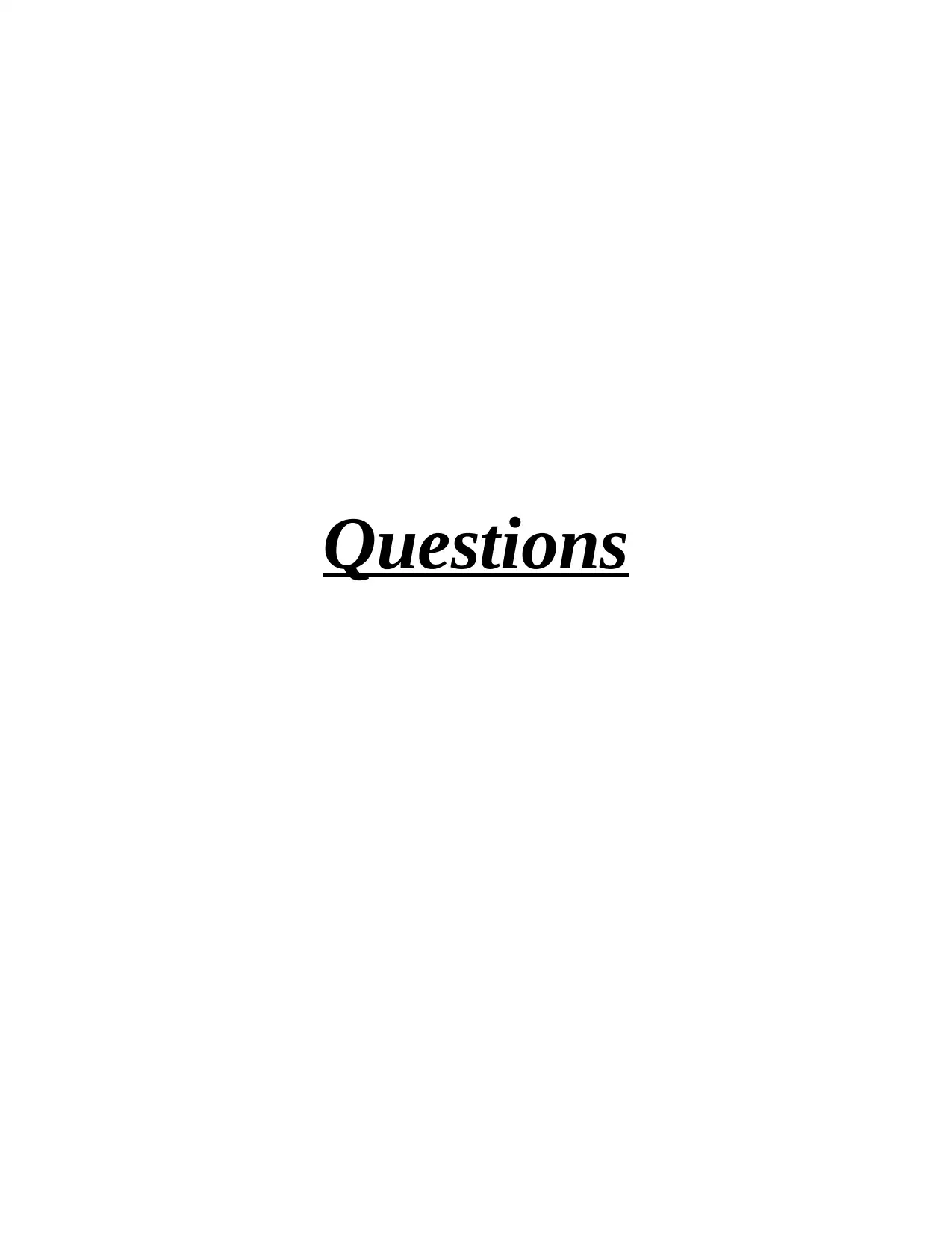
Questions
Paraphrase This Document
Need a fresh take? Get an instant paraphrase of this document with our AI Paraphraser
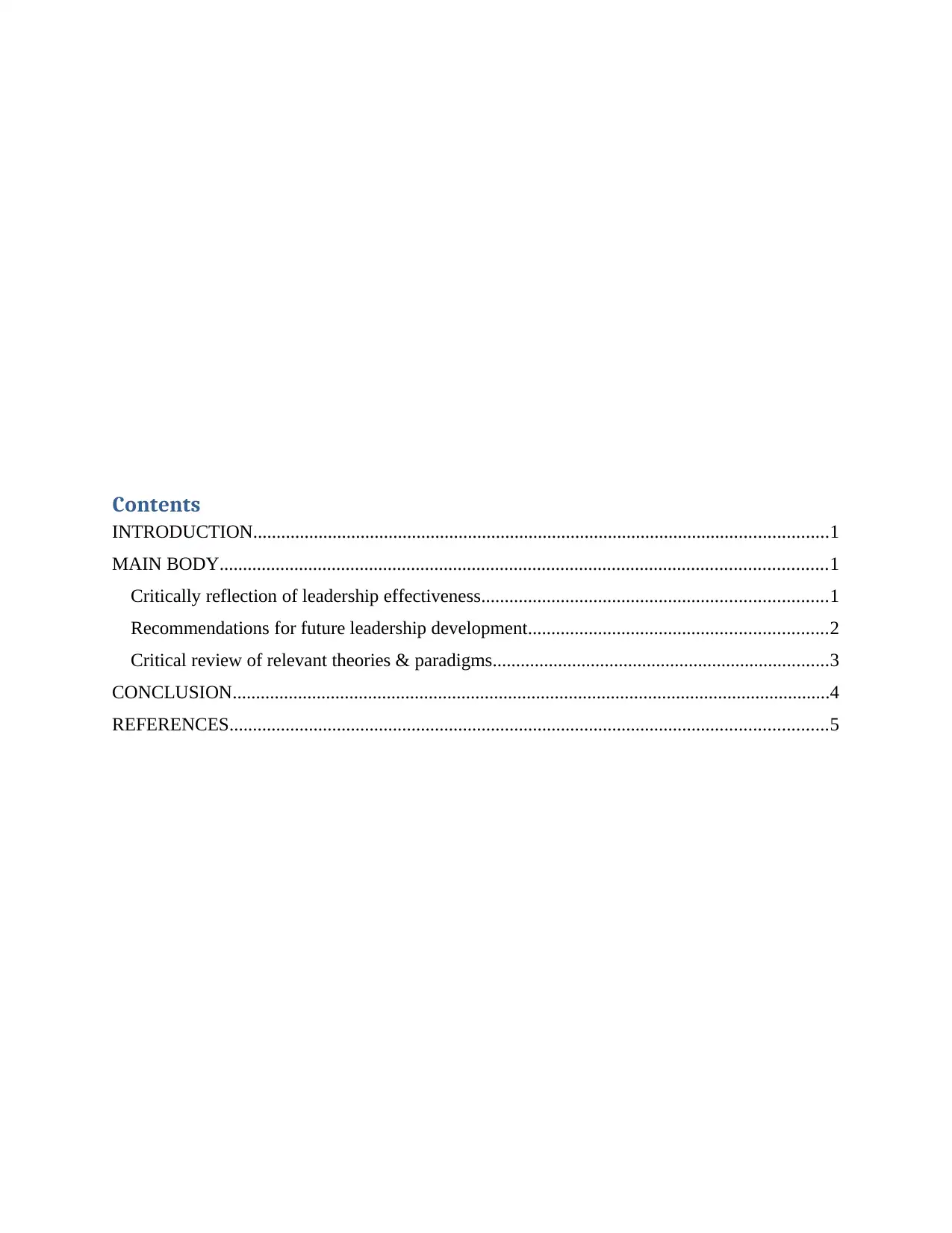
Contents
INTRODUCTION...........................................................................................................................1
MAIN BODY..................................................................................................................................1
Critically reflection of leadership effectiveness..........................................................................1
Recommendations for future leadership development................................................................2
Critical review of relevant theories & paradigms........................................................................3
CONCLUSION................................................................................................................................4
REFERENCES................................................................................................................................5
INTRODUCTION...........................................................................................................................1
MAIN BODY..................................................................................................................................1
Critically reflection of leadership effectiveness..........................................................................1
Recommendations for future leadership development................................................................2
Critical review of relevant theories & paradigms........................................................................3
CONCLUSION................................................................................................................................4
REFERENCES................................................................................................................................5
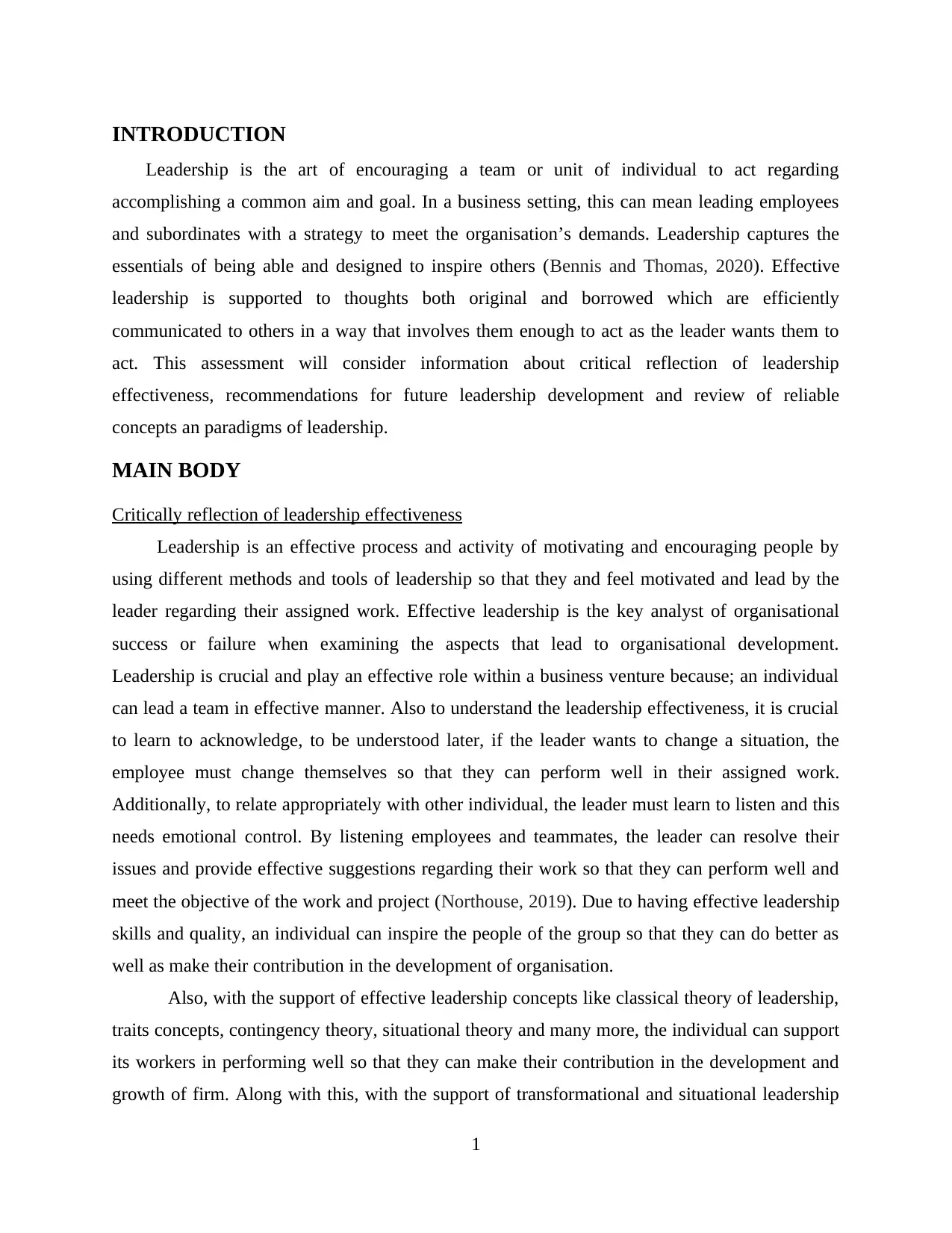
INTRODUCTION
Leadership is the art of encouraging a team or unit of individual to act regarding
accomplishing a common aim and goal. In a business setting, this can mean leading employees
and subordinates with a strategy to meet the organisation’s demands. Leadership captures the
essentials of being able and designed to inspire others (Bennis and Thomas, 2020). Effective
leadership is supported to thoughts both original and borrowed which are efficiently
communicated to others in a way that involves them enough to act as the leader wants them to
act. This assessment will consider information about critical reflection of leadership
effectiveness, recommendations for future leadership development and review of reliable
concepts an paradigms of leadership.
MAIN BODY
Critically reflection of leadership effectiveness
Leadership is an effective process and activity of motivating and encouraging people by
using different methods and tools of leadership so that they and feel motivated and lead by the
leader regarding their assigned work. Effective leadership is the key analyst of organisational
success or failure when examining the aspects that lead to organisational development.
Leadership is crucial and play an effective role within a business venture because; an individual
can lead a team in effective manner. Also to understand the leadership effectiveness, it is crucial
to learn to acknowledge, to be understood later, if the leader wants to change a situation, the
employee must change themselves so that they can perform well in their assigned work.
Additionally, to relate appropriately with other individual, the leader must learn to listen and this
needs emotional control. By listening employees and teammates, the leader can resolve their
issues and provide effective suggestions regarding their work so that they can perform well and
meet the objective of the work and project (Northouse, 2019). Due to having effective leadership
skills and quality, an individual can inspire the people of the group so that they can do better as
well as make their contribution in the development of organisation.
Also, with the support of effective leadership concepts like classical theory of leadership,
traits concepts, contingency theory, situational theory and many more, the individual can support
its workers in performing well so that they can make their contribution in the development and
growth of firm. Along with this, with the support of transformational and situational leadership
1
Leadership is the art of encouraging a team or unit of individual to act regarding
accomplishing a common aim and goal. In a business setting, this can mean leading employees
and subordinates with a strategy to meet the organisation’s demands. Leadership captures the
essentials of being able and designed to inspire others (Bennis and Thomas, 2020). Effective
leadership is supported to thoughts both original and borrowed which are efficiently
communicated to others in a way that involves them enough to act as the leader wants them to
act. This assessment will consider information about critical reflection of leadership
effectiveness, recommendations for future leadership development and review of reliable
concepts an paradigms of leadership.
MAIN BODY
Critically reflection of leadership effectiveness
Leadership is an effective process and activity of motivating and encouraging people by
using different methods and tools of leadership so that they and feel motivated and lead by the
leader regarding their assigned work. Effective leadership is the key analyst of organisational
success or failure when examining the aspects that lead to organisational development.
Leadership is crucial and play an effective role within a business venture because; an individual
can lead a team in effective manner. Also to understand the leadership effectiveness, it is crucial
to learn to acknowledge, to be understood later, if the leader wants to change a situation, the
employee must change themselves so that they can perform well in their assigned work.
Additionally, to relate appropriately with other individual, the leader must learn to listen and this
needs emotional control. By listening employees and teammates, the leader can resolve their
issues and provide effective suggestions regarding their work so that they can perform well and
meet the objective of the work and project (Northouse, 2019). Due to having effective leadership
skills and quality, an individual can inspire the people of the group so that they can do better as
well as make their contribution in the development of organisation.
Also, with the support of effective leadership concepts like classical theory of leadership,
traits concepts, contingency theory, situational theory and many more, the individual can support
its workers in performing well so that they can make their contribution in the development and
growth of firm. Along with this, with the support of transformational and situational leadership
1
⊘ This is a preview!⊘
Do you want full access?
Subscribe today to unlock all pages.

Trusted by 1+ million students worldwide
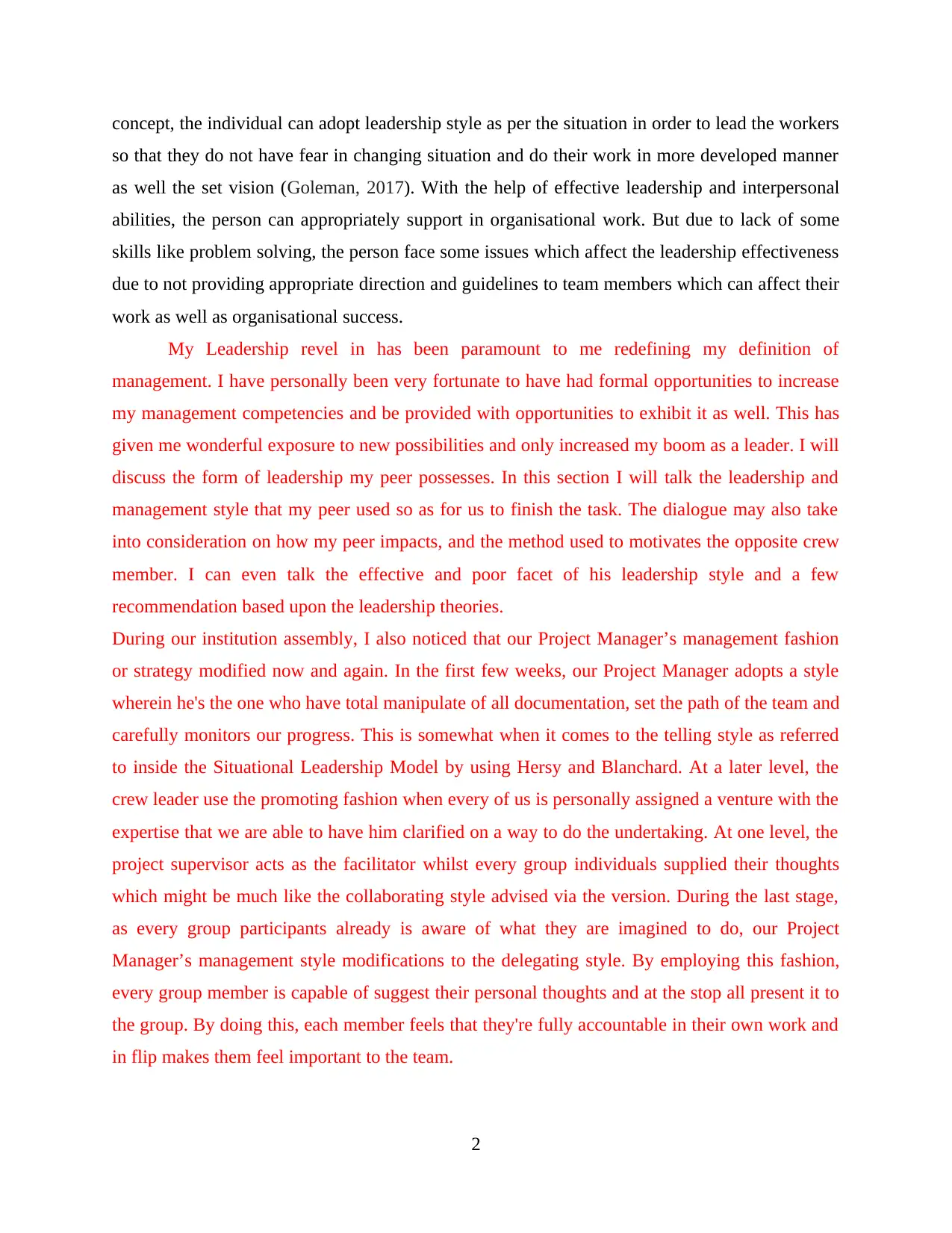
concept, the individual can adopt leadership style as per the situation in order to lead the workers
so that they do not have fear in changing situation and do their work in more developed manner
as well the set vision (Goleman, 2017). With the help of effective leadership and interpersonal
abilities, the person can appropriately support in organisational work. But due to lack of some
skills like problem solving, the person face some issues which affect the leadership effectiveness
due to not providing appropriate direction and guidelines to team members which can affect their
work as well as organisational success.
My Leadership revel in has been paramount to me redefining my definition of
management. I have personally been very fortunate to have had formal opportunities to increase
my management competencies and be provided with opportunities to exhibit it as well. This has
given me wonderful exposure to new possibilities and only increased my boom as a leader. I will
discuss the form of leadership my peer possesses. In this section I will talk the leadership and
management style that my peer used so as for us to finish the task. The dialogue may also take
into consideration on how my peer impacts, and the method used to motivates the opposite crew
member. I can even talk the effective and poor facet of his leadership style and a few
recommendation based upon the leadership theories.
During our institution assembly, I also noticed that our Project Manager’s management fashion
or strategy modified now and again. In the first few weeks, our Project Manager adopts a style
wherein he's the one who have total manipulate of all documentation, set the path of the team and
carefully monitors our progress. This is somewhat when it comes to the telling style as referred
to inside the Situational Leadership Model by using Hersy and Blanchard. At a later level, the
crew leader use the promoting fashion when every of us is personally assigned a venture with the
expertise that we are able to have him clarified on a way to do the undertaking. At one level, the
project supervisor acts as the facilitator whilst every group individuals supplied their thoughts
which might be much like the collaborating style advised via the version. During the last stage,
as every group participants already is aware of what they are imagined to do, our Project
Manager’s management style modifications to the delegating style. By employing this fashion,
every group member is capable of suggest their personal thoughts and at the stop all present it to
the group. By doing this, each member feels that they're fully accountable in their own work and
in flip makes them feel important to the team.
2
so that they do not have fear in changing situation and do their work in more developed manner
as well the set vision (Goleman, 2017). With the help of effective leadership and interpersonal
abilities, the person can appropriately support in organisational work. But due to lack of some
skills like problem solving, the person face some issues which affect the leadership effectiveness
due to not providing appropriate direction and guidelines to team members which can affect their
work as well as organisational success.
My Leadership revel in has been paramount to me redefining my definition of
management. I have personally been very fortunate to have had formal opportunities to increase
my management competencies and be provided with opportunities to exhibit it as well. This has
given me wonderful exposure to new possibilities and only increased my boom as a leader. I will
discuss the form of leadership my peer possesses. In this section I will talk the leadership and
management style that my peer used so as for us to finish the task. The dialogue may also take
into consideration on how my peer impacts, and the method used to motivates the opposite crew
member. I can even talk the effective and poor facet of his leadership style and a few
recommendation based upon the leadership theories.
During our institution assembly, I also noticed that our Project Manager’s management fashion
or strategy modified now and again. In the first few weeks, our Project Manager adopts a style
wherein he's the one who have total manipulate of all documentation, set the path of the team and
carefully monitors our progress. This is somewhat when it comes to the telling style as referred
to inside the Situational Leadership Model by using Hersy and Blanchard. At a later level, the
crew leader use the promoting fashion when every of us is personally assigned a venture with the
expertise that we are able to have him clarified on a way to do the undertaking. At one level, the
project supervisor acts as the facilitator whilst every group individuals supplied their thoughts
which might be much like the collaborating style advised via the version. During the last stage,
as every group participants already is aware of what they are imagined to do, our Project
Manager’s management style modifications to the delegating style. By employing this fashion,
every group member is capable of suggest their personal thoughts and at the stop all present it to
the group. By doing this, each member feels that they're fully accountable in their own work and
in flip makes them feel important to the team.
2
Paraphrase This Document
Need a fresh take? Get an instant paraphrase of this document with our AI Paraphraser
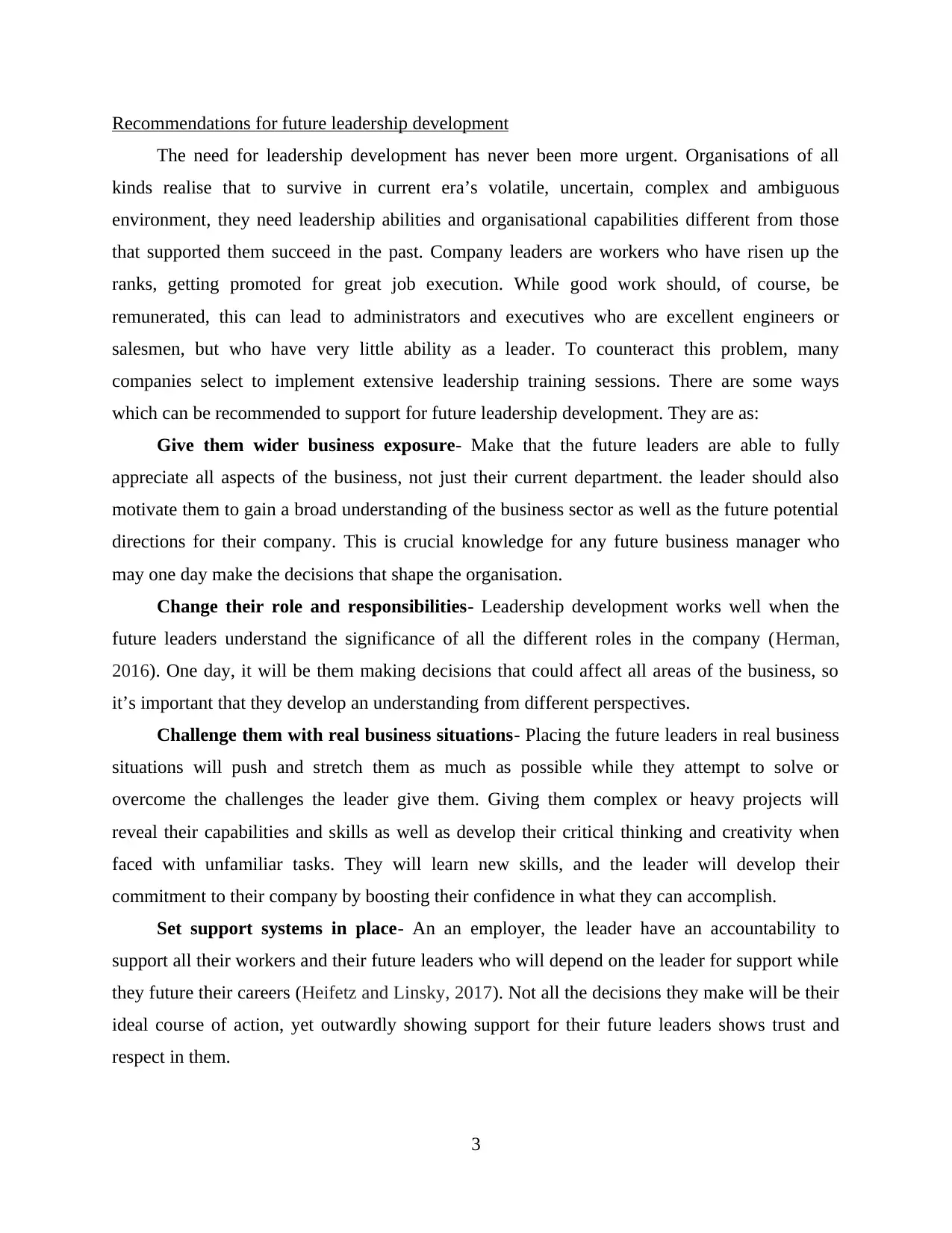
Recommendations for future leadership development
The need for leadership development has never been more urgent. Organisations of all
kinds realise that to survive in current era’s volatile, uncertain, complex and ambiguous
environment, they need leadership abilities and organisational capabilities different from those
that supported them succeed in the past. Company leaders are workers who have risen up the
ranks, getting promoted for great job execution. While good work should, of course, be
remunerated, this can lead to administrators and executives who are excellent engineers or
salesmen, but who have very little ability as a leader. To counteract this problem, many
companies select to implement extensive leadership training sessions. There are some ways
which can be recommended to support for future leadership development. They are as:
Give them wider business exposure- Make that the future leaders are able to fully
appreciate all aspects of the business, not just their current department. the leader should also
motivate them to gain a broad understanding of the business sector as well as the future potential
directions for their company. This is crucial knowledge for any future business manager who
may one day make the decisions that shape the organisation.
Change their role and responsibilities- Leadership development works well when the
future leaders understand the significance of all the different roles in the company (Herman,
2016). One day, it will be them making decisions that could affect all areas of the business, so
it’s important that they develop an understanding from different perspectives.
Challenge them with real business situations- Placing the future leaders in real business
situations will push and stretch them as much as possible while they attempt to solve or
overcome the challenges the leader give them. Giving them complex or heavy projects will
reveal their capabilities and skills as well as develop their critical thinking and creativity when
faced with unfamiliar tasks. They will learn new skills, and the leader will develop their
commitment to their company by boosting their confidence in what they can accomplish.
Set support systems in place- An an employer, the leader have an accountability to
support all their workers and their future leaders who will depend on the leader for support while
they future their careers (Heifetz and Linsky, 2017). Not all the decisions they make will be their
ideal course of action, yet outwardly showing support for their future leaders shows trust and
respect in them.
3
The need for leadership development has never been more urgent. Organisations of all
kinds realise that to survive in current era’s volatile, uncertain, complex and ambiguous
environment, they need leadership abilities and organisational capabilities different from those
that supported them succeed in the past. Company leaders are workers who have risen up the
ranks, getting promoted for great job execution. While good work should, of course, be
remunerated, this can lead to administrators and executives who are excellent engineers or
salesmen, but who have very little ability as a leader. To counteract this problem, many
companies select to implement extensive leadership training sessions. There are some ways
which can be recommended to support for future leadership development. They are as:
Give them wider business exposure- Make that the future leaders are able to fully
appreciate all aspects of the business, not just their current department. the leader should also
motivate them to gain a broad understanding of the business sector as well as the future potential
directions for their company. This is crucial knowledge for any future business manager who
may one day make the decisions that shape the organisation.
Change their role and responsibilities- Leadership development works well when the
future leaders understand the significance of all the different roles in the company (Herman,
2016). One day, it will be them making decisions that could affect all areas of the business, so
it’s important that they develop an understanding from different perspectives.
Challenge them with real business situations- Placing the future leaders in real business
situations will push and stretch them as much as possible while they attempt to solve or
overcome the challenges the leader give them. Giving them complex or heavy projects will
reveal their capabilities and skills as well as develop their critical thinking and creativity when
faced with unfamiliar tasks. They will learn new skills, and the leader will develop their
commitment to their company by boosting their confidence in what they can accomplish.
Set support systems in place- An an employer, the leader have an accountability to
support all their workers and their future leaders who will depend on the leader for support while
they future their careers (Heifetz and Linsky, 2017). Not all the decisions they make will be their
ideal course of action, yet outwardly showing support for their future leaders shows trust and
respect in them.
3
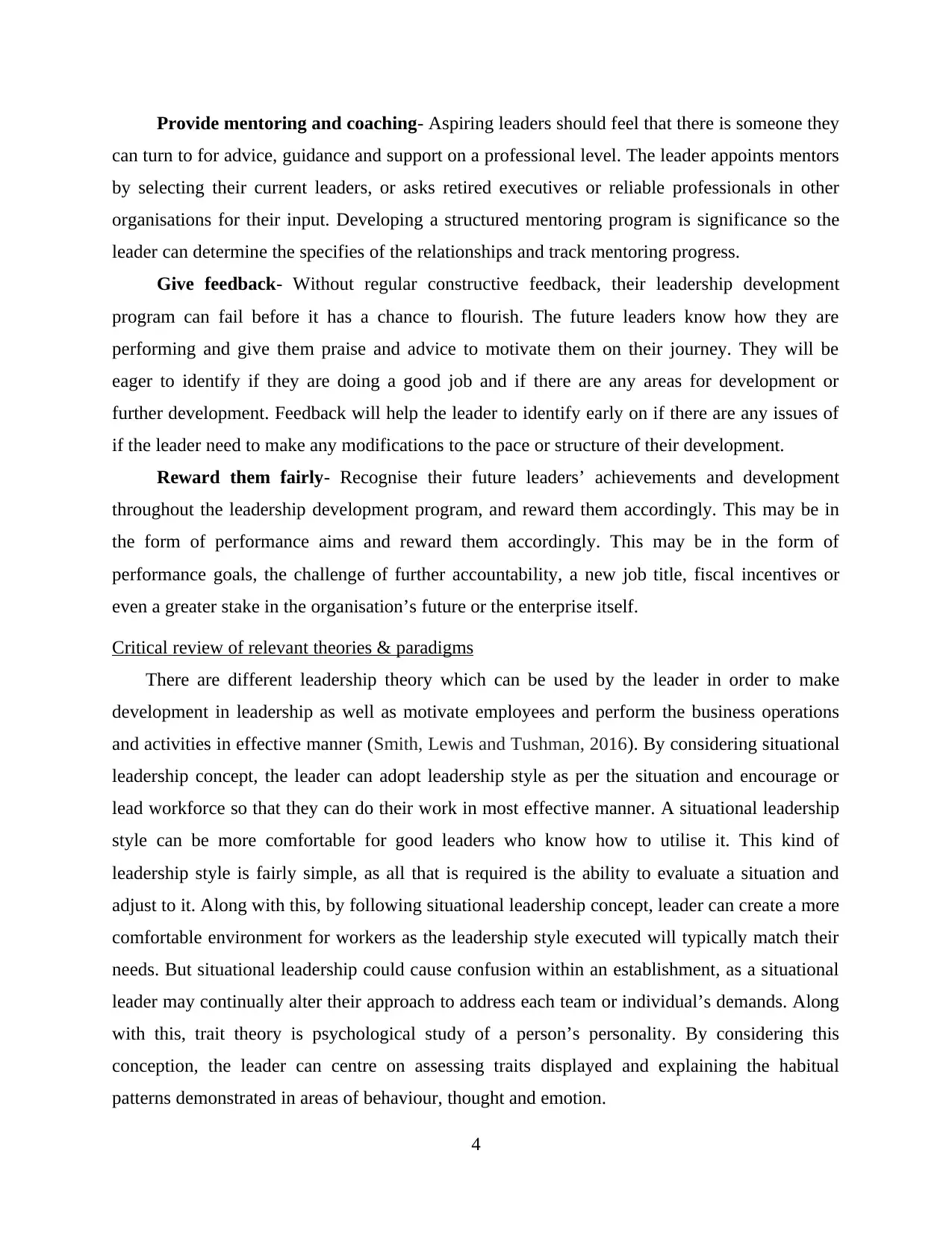
Provide mentoring and coaching- Aspiring leaders should feel that there is someone they
can turn to for advice, guidance and support on a professional level. The leader appoints mentors
by selecting their current leaders, or asks retired executives or reliable professionals in other
organisations for their input. Developing a structured mentoring program is significance so the
leader can determine the specifies of the relationships and track mentoring progress.
Give feedback- Without regular constructive feedback, their leadership development
program can fail before it has a chance to flourish. The future leaders know how they are
performing and give them praise and advice to motivate them on their journey. They will be
eager to identify if they are doing a good job and if there are any areas for development or
further development. Feedback will help the leader to identify early on if there are any issues of
if the leader need to make any modifications to the pace or structure of their development.
Reward them fairly- Recognise their future leaders’ achievements and development
throughout the leadership development program, and reward them accordingly. This may be in
the form of performance aims and reward them accordingly. This may be in the form of
performance goals, the challenge of further accountability, a new job title, fiscal incentives or
even a greater stake in the organisation’s future or the enterprise itself.
Critical review of relevant theories & paradigms
There are different leadership theory which can be used by the leader in order to make
development in leadership as well as motivate employees and perform the business operations
and activities in effective manner (Smith, Lewis and Tushman, 2016). By considering situational
leadership concept, the leader can adopt leadership style as per the situation and encourage or
lead workforce so that they can do their work in most effective manner. A situational leadership
style can be more comfortable for good leaders who know how to utilise it. This kind of
leadership style is fairly simple, as all that is required is the ability to evaluate a situation and
adjust to it. Along with this, by following situational leadership concept, leader can create a more
comfortable environment for workers as the leadership style executed will typically match their
needs. But situational leadership could cause confusion within an establishment, as a situational
leader may continually alter their approach to address each team or individual’s demands. Along
with this, trait theory is psychological study of a person’s personality. By considering this
conception, the leader can centre on assessing traits displayed and explaining the habitual
patterns demonstrated in areas of behaviour, thought and emotion.
4
can turn to for advice, guidance and support on a professional level. The leader appoints mentors
by selecting their current leaders, or asks retired executives or reliable professionals in other
organisations for their input. Developing a structured mentoring program is significance so the
leader can determine the specifies of the relationships and track mentoring progress.
Give feedback- Without regular constructive feedback, their leadership development
program can fail before it has a chance to flourish. The future leaders know how they are
performing and give them praise and advice to motivate them on their journey. They will be
eager to identify if they are doing a good job and if there are any areas for development or
further development. Feedback will help the leader to identify early on if there are any issues of
if the leader need to make any modifications to the pace or structure of their development.
Reward them fairly- Recognise their future leaders’ achievements and development
throughout the leadership development program, and reward them accordingly. This may be in
the form of performance aims and reward them accordingly. This may be in the form of
performance goals, the challenge of further accountability, a new job title, fiscal incentives or
even a greater stake in the organisation’s future or the enterprise itself.
Critical review of relevant theories & paradigms
There are different leadership theory which can be used by the leader in order to make
development in leadership as well as motivate employees and perform the business operations
and activities in effective manner (Smith, Lewis and Tushman, 2016). By considering situational
leadership concept, the leader can adopt leadership style as per the situation and encourage or
lead workforce so that they can do their work in most effective manner. A situational leadership
style can be more comfortable for good leaders who know how to utilise it. This kind of
leadership style is fairly simple, as all that is required is the ability to evaluate a situation and
adjust to it. Along with this, by following situational leadership concept, leader can create a more
comfortable environment for workers as the leadership style executed will typically match their
needs. But situational leadership could cause confusion within an establishment, as a situational
leader may continually alter their approach to address each team or individual’s demands. Along
with this, trait theory is psychological study of a person’s personality. By considering this
conception, the leader can centre on assessing traits displayed and explaining the habitual
patterns demonstrated in areas of behaviour, thought and emotion.
4
⊘ This is a preview!⊘
Do you want full access?
Subscribe today to unlock all pages.

Trusted by 1+ million students worldwide
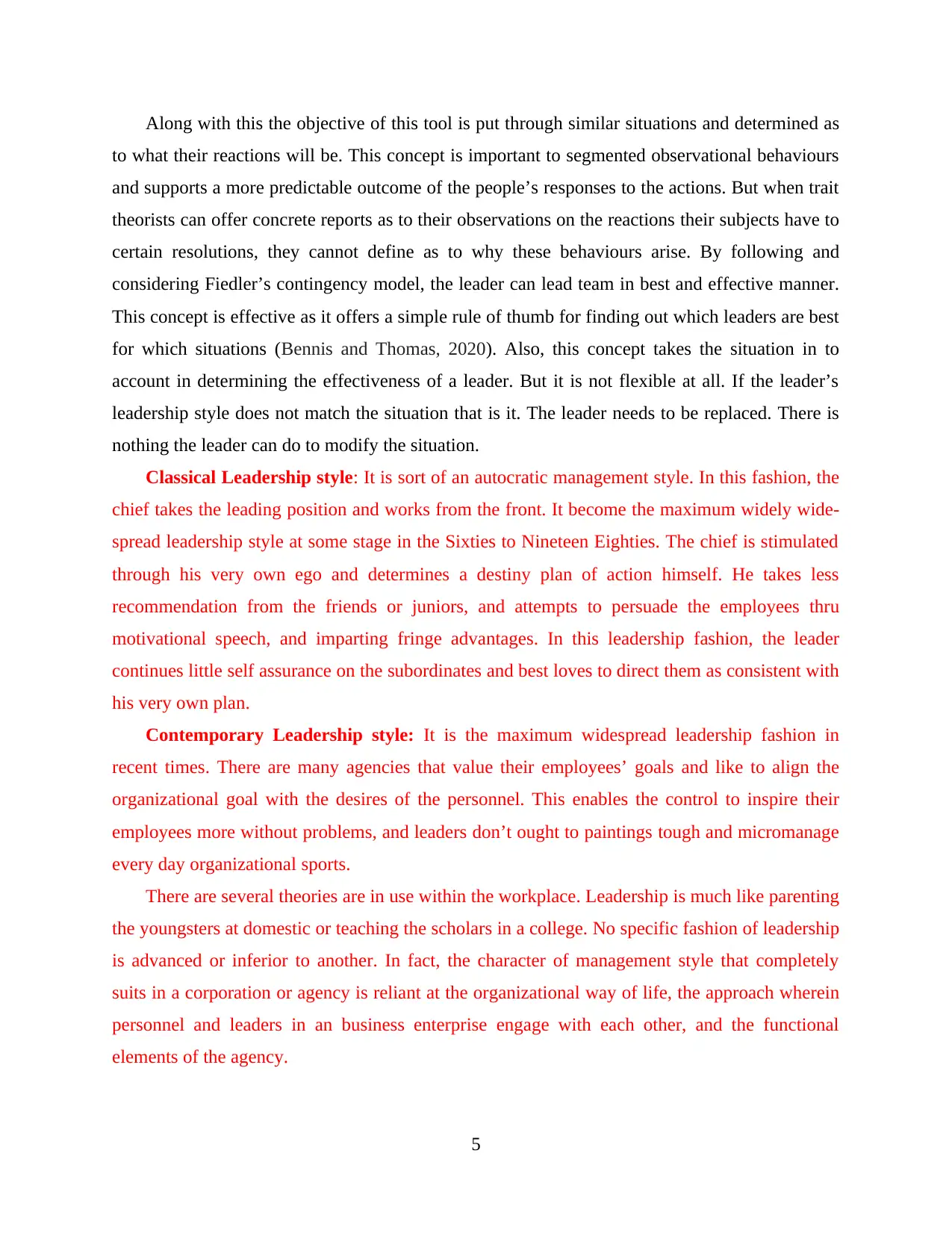
Along with this the objective of this tool is put through similar situations and determined as
to what their reactions will be. This concept is important to segmented observational behaviours
and supports a more predictable outcome of the people’s responses to the actions. But when trait
theorists can offer concrete reports as to their observations on the reactions their subjects have to
certain resolutions, they cannot define as to why these behaviours arise. By following and
considering Fiedler’s contingency model, the leader can lead team in best and effective manner.
This concept is effective as it offers a simple rule of thumb for finding out which leaders are best
for which situations (Bennis and Thomas, 2020). Also, this concept takes the situation in to
account in determining the effectiveness of a leader. But it is not flexible at all. If the leader’s
leadership style does not match the situation that is it. The leader needs to be replaced. There is
nothing the leader can do to modify the situation.
Classical Leadership style: It is sort of an autocratic management style. In this fashion, the
chief takes the leading position and works from the front. It become the maximum widely wide-
spread leadership style at some stage in the Sixties to Nineteen Eighties. The chief is stimulated
through his very own ego and determines a destiny plan of action himself. He takes less
recommendation from the friends or juniors, and attempts to persuade the employees thru
motivational speech, and imparting fringe advantages. In this leadership fashion, the leader
continues little self assurance on the subordinates and best loves to direct them as consistent with
his very own plan.
Contemporary Leadership style: It is the maximum widespread leadership fashion in
recent times. There are many agencies that value their employees’ goals and like to align the
organizational goal with the desires of the personnel. This enables the control to inspire their
employees more without problems, and leaders don’t ought to paintings tough and micromanage
every day organizational sports.
There are several theories are in use within the workplace. Leadership is much like parenting
the youngsters at domestic or teaching the scholars in a college. No specific fashion of leadership
is advanced or inferior to another. In fact, the character of management style that completely
suits in a corporation or agency is reliant at the organizational way of life, the approach wherein
personnel and leaders in an business enterprise engage with each other, and the functional
elements of the agency.
5
to what their reactions will be. This concept is important to segmented observational behaviours
and supports a more predictable outcome of the people’s responses to the actions. But when trait
theorists can offer concrete reports as to their observations on the reactions their subjects have to
certain resolutions, they cannot define as to why these behaviours arise. By following and
considering Fiedler’s contingency model, the leader can lead team in best and effective manner.
This concept is effective as it offers a simple rule of thumb for finding out which leaders are best
for which situations (Bennis and Thomas, 2020). Also, this concept takes the situation in to
account in determining the effectiveness of a leader. But it is not flexible at all. If the leader’s
leadership style does not match the situation that is it. The leader needs to be replaced. There is
nothing the leader can do to modify the situation.
Classical Leadership style: It is sort of an autocratic management style. In this fashion, the
chief takes the leading position and works from the front. It become the maximum widely wide-
spread leadership style at some stage in the Sixties to Nineteen Eighties. The chief is stimulated
through his very own ego and determines a destiny plan of action himself. He takes less
recommendation from the friends or juniors, and attempts to persuade the employees thru
motivational speech, and imparting fringe advantages. In this leadership fashion, the leader
continues little self assurance on the subordinates and best loves to direct them as consistent with
his very own plan.
Contemporary Leadership style: It is the maximum widespread leadership fashion in
recent times. There are many agencies that value their employees’ goals and like to align the
organizational goal with the desires of the personnel. This enables the control to inspire their
employees more without problems, and leaders don’t ought to paintings tough and micromanage
every day organizational sports.
There are several theories are in use within the workplace. Leadership is much like parenting
the youngsters at domestic or teaching the scholars in a college. No specific fashion of leadership
is advanced or inferior to another. In fact, the character of management style that completely
suits in a corporation or agency is reliant at the organizational way of life, the approach wherein
personnel and leaders in an business enterprise engage with each other, and the functional
elements of the agency.
5
Paraphrase This Document
Need a fresh take? Get an instant paraphrase of this document with our AI Paraphraser
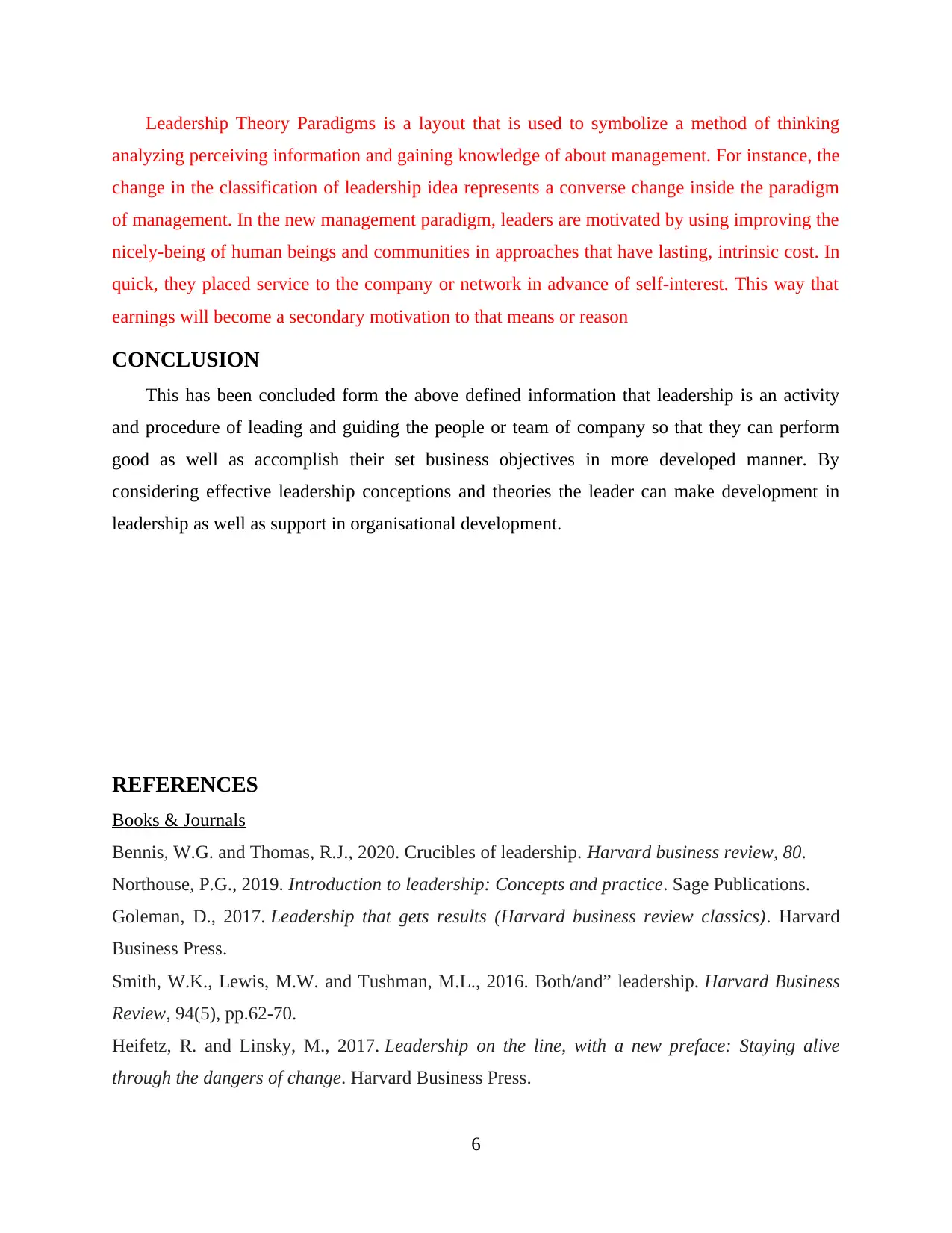
Leadership Theory Paradigms is a layout that is used to symbolize a method of thinking
analyzing perceiving information and gaining knowledge of about management. For instance, the
change in the classification of leadership idea represents a converse change inside the paradigm
of management. In the new management paradigm, leaders are motivated by using improving the
nicely-being of human beings and communities in approaches that have lasting, intrinsic cost. In
quick, they placed service to the company or network in advance of self-interest. This way that
earnings will become a secondary motivation to that means or reason
CONCLUSION
This has been concluded form the above defined information that leadership is an activity
and procedure of leading and guiding the people or team of company so that they can perform
good as well as accomplish their set business objectives in more developed manner. By
considering effective leadership conceptions and theories the leader can make development in
leadership as well as support in organisational development.
REFERENCES
Books & Journals
Bennis, W.G. and Thomas, R.J., 2020. Crucibles of leadership. Harvard business review, 80.
Northouse, P.G., 2019. Introduction to leadership: Concepts and practice. Sage Publications.
Goleman, D., 2017. Leadership that gets results (Harvard business review classics). Harvard
Business Press.
Smith, W.K., Lewis, M.W. and Tushman, M.L., 2016. Both/and” leadership. Harvard Business
Review, 94(5), pp.62-70.
Heifetz, R. and Linsky, M., 2017. Leadership on the line, with a new preface: Staying alive
through the dangers of change. Harvard Business Press.
6
analyzing perceiving information and gaining knowledge of about management. For instance, the
change in the classification of leadership idea represents a converse change inside the paradigm
of management. In the new management paradigm, leaders are motivated by using improving the
nicely-being of human beings and communities in approaches that have lasting, intrinsic cost. In
quick, they placed service to the company or network in advance of self-interest. This way that
earnings will become a secondary motivation to that means or reason
CONCLUSION
This has been concluded form the above defined information that leadership is an activity
and procedure of leading and guiding the people or team of company so that they can perform
good as well as accomplish their set business objectives in more developed manner. By
considering effective leadership conceptions and theories the leader can make development in
leadership as well as support in organisational development.
REFERENCES
Books & Journals
Bennis, W.G. and Thomas, R.J., 2020. Crucibles of leadership. Harvard business review, 80.
Northouse, P.G., 2019. Introduction to leadership: Concepts and practice. Sage Publications.
Goleman, D., 2017. Leadership that gets results (Harvard business review classics). Harvard
Business Press.
Smith, W.K., Lewis, M.W. and Tushman, M.L., 2016. Both/and” leadership. Harvard Business
Review, 94(5), pp.62-70.
Heifetz, R. and Linsky, M., 2017. Leadership on the line, with a new preface: Staying alive
through the dangers of change. Harvard Business Press.
6
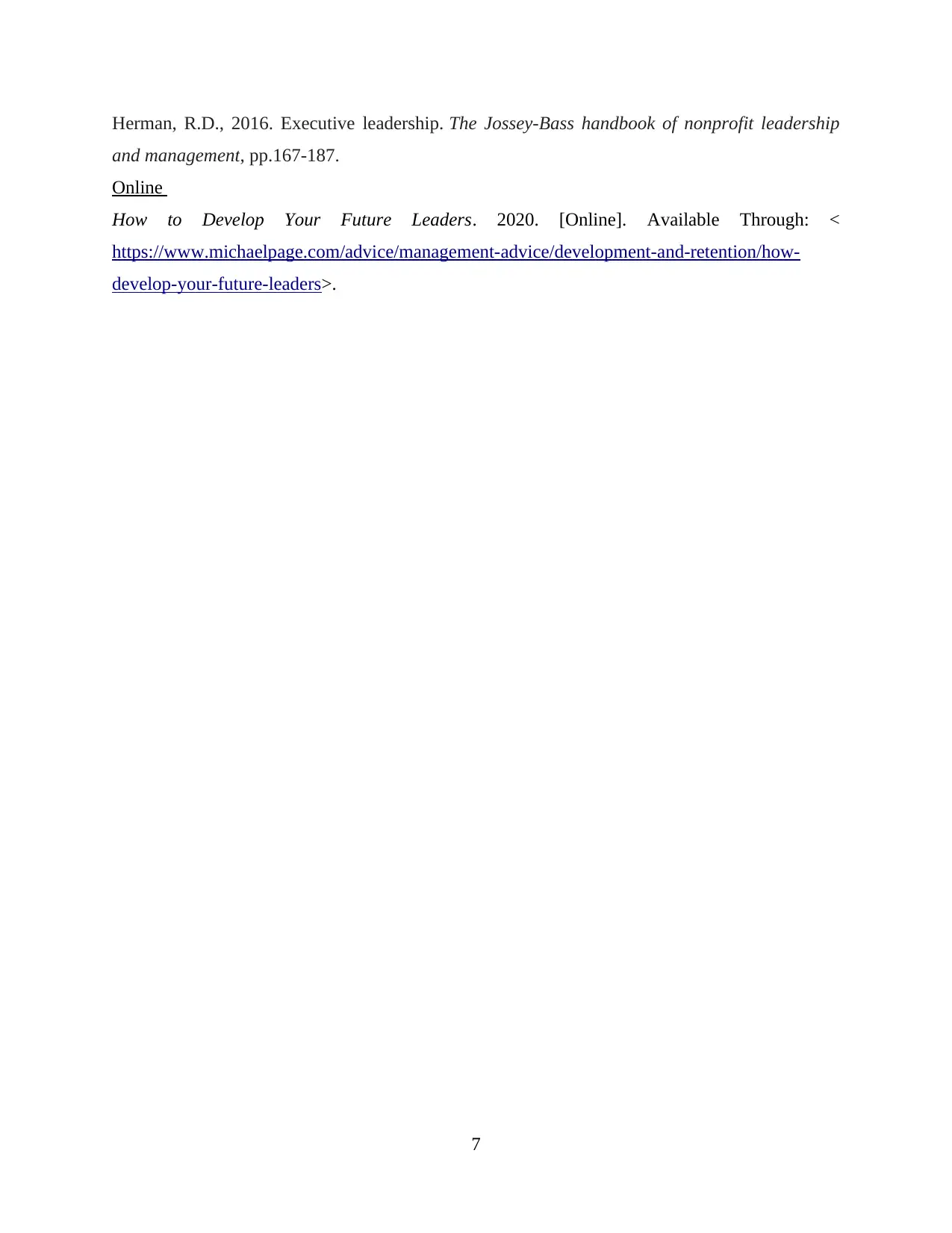
Herman, R.D., 2016. Executive leadership. The Jossey-Bass handbook of nonprofit leadership
and management, pp.167-187.
Online
How to Develop Your Future Leaders. 2020. [Online]. Available Through: <
https://www.michaelpage.com/advice/management-advice/development-and-retention/how-
develop-your-future-leaders>.
7
and management, pp.167-187.
Online
How to Develop Your Future Leaders. 2020. [Online]. Available Through: <
https://www.michaelpage.com/advice/management-advice/development-and-retention/how-
develop-your-future-leaders>.
7
⊘ This is a preview!⊘
Do you want full access?
Subscribe today to unlock all pages.

Trusted by 1+ million students worldwide
1 out of 9
Related Documents
Your All-in-One AI-Powered Toolkit for Academic Success.
+13062052269
info@desklib.com
Available 24*7 on WhatsApp / Email
![[object Object]](/_next/static/media/star-bottom.7253800d.svg)
Unlock your academic potential
Copyright © 2020–2025 A2Z Services. All Rights Reserved. Developed and managed by ZUCOL.



